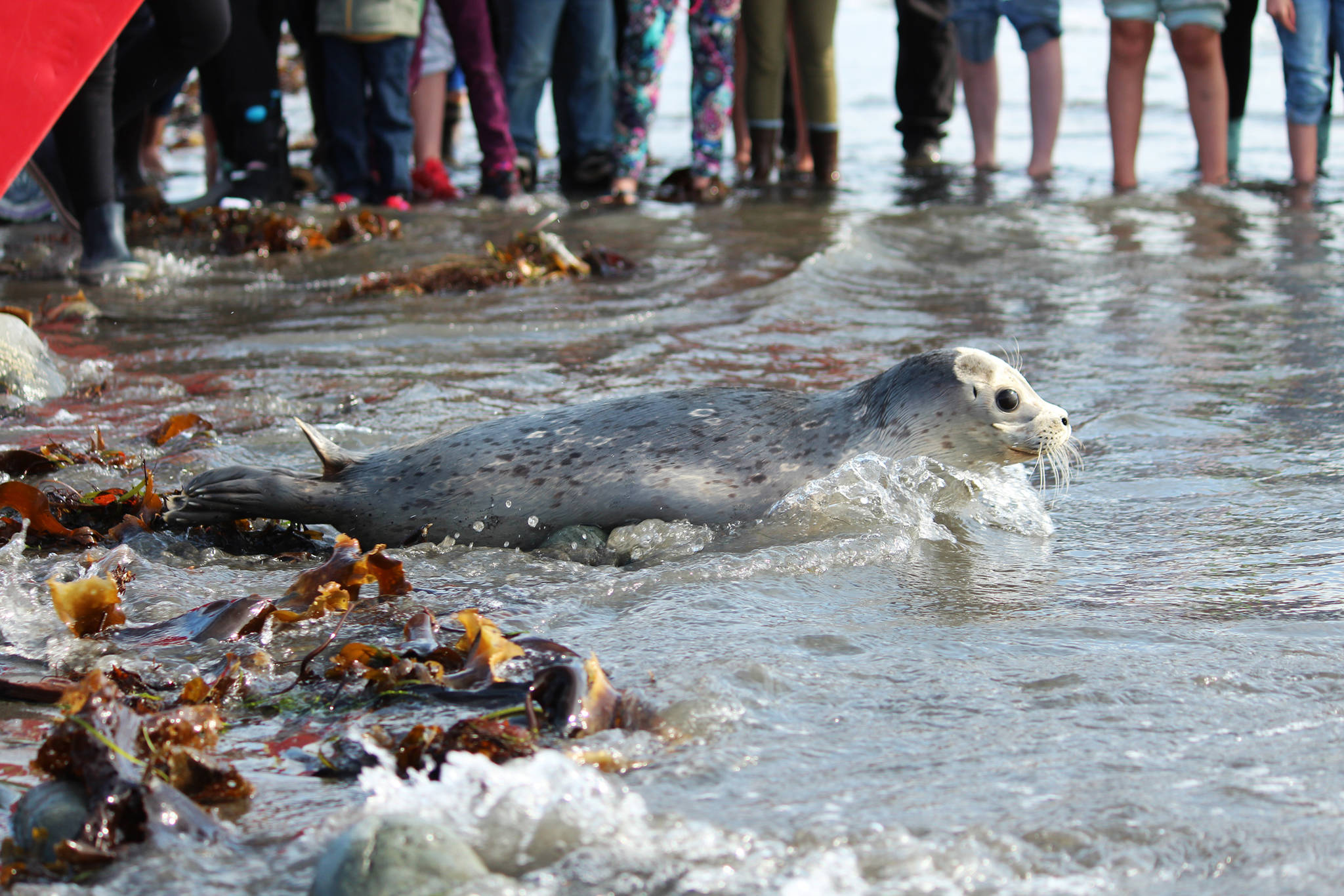Two young harbor seals are back where they belong after being rehabilitated through the Alaska SeaLife Center’s Wildlife Response Program and released into Kachemak Bay.
Dozens of people gathered at Bishop’s Beach last Thursday to watch as the two seals — Ugashik “Uggy” and Charley Fritz — were released into the waters of Kachemak Bay in Homer by Sealife Center staff and volunteers. Uggy was found neglected by her mother on May 29 on a beach near McNeil Canyon and Fritz was found neglected by his mother on a beach near Homer on May 12, according to an information sheet provided by the SeaLife Center. At that time, both were estimated to be only a week to two weeks old, said Jane Belovarac, curator for the Wildlife Response Program.
Fritz and Uggy were able to be released because they had graduated that program. In order to be released back into the wild, animals must pass all final health checks, not be on any medications, and be able to show that they can hunt, Belovarac said.
“Seals are under NOAA and the National Mariner Fisheries Service,” she said. “And so they have certain protocols and milestones that we need to hit in order for the animal to be released.”
One of those milestones is that the seals must be a certain weight before being released. Both Uggy and Fritz now weigh over 20 kilograms. Each of them was fitted with a numbered tag on their hind flipper so that, if they are observed in the wild in the future, they will be identifiable.
“Uggy and Charley’s rehabilitation care evolved around monitoring each seal’s progress, starting with supervised swims and tube feedings of nutritive formula,” according to the information sheet from the center. “Their initial stages required hands-on treatments and routine examinations, but over the course of their stay, human interaction was greatly reduced. As they advanced through the program, they graduated to a larger pool where they were united and demonstrated their ability to forage and compete for fish.”
A goal of the Wildlife Response program is to return healthy animals to the areas where they were found, or as close as possible. That’s part of why the SeaLife Center chose to release them at Bishop’s Beach, Belovarac said. Another reason is that the beach is an easy public access point.
People were allowed to ask questions of volunteers and, when it came time to send Uggy and Fritz back to the ocean, formed two long lines on the rocky beach. It created a wide causeway for the seals to scoot down until they reached the water and swam out into the bay.
“We want to share the excitement of a release with everyone,” Belovarac said of why the event was made public. “This is a great way to inspire the community, because it’s because of the community that we get calls about stranded animals. So being able for folks to see the animals they might have called about … it’s just a great way for the community to celebrate the things that we do.”
It was a few of the roughly 20 Homer based volunteers for the center that helped with rescuing the seals in the first place. When the SeaLife Center gets a call about an animal, it sends one of the Homer volunteers to assess out the situation and report back. Then the center makes the final call about what should be done.
“The Homer volunteers are instrumental to being our eyes and ears out here,” Belovarac said.
Volunteers are also sent out to collect data for the center when dead marine animals are found on beaches.
Belovarac cautioned that physically removing a marine animal from its habitat should not be the first step.
People who spot animals that appear to be in distress should always check with the center first.
“We just want to encourage people, if they see something, call first before they pick up,” she said. “Because some animals look rather distressed when they’re out of water, but that could be normal. Like sea otters — they scream a lot, and that’s absolutely normal.”
The number to call if you see a stranded marine animal is 888-774-7325(SEAL).
Reach Megan Pacer at mpacer@homernews.com.


